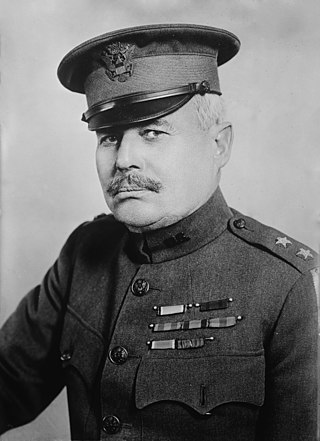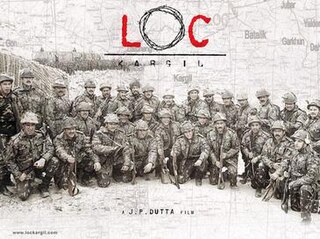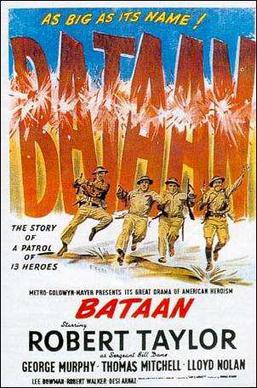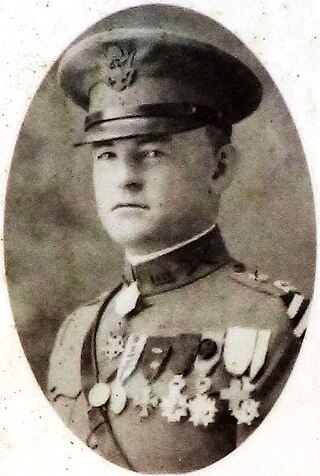
Cher Ami was a male homing pigeon who had been donated by the pigeon fanciers of Britain for use by the U.S. Army Signal Corps in France during World War I and had been trained by American pigeoners. He is famous for delivering a message from an encircled battalion despite serious injuries during the Meuse-Argonne offensive in October 1918.

The 77th Sustainment Brigade is a unit of the United States Army that inherited the lineage of the 77th Infantry Division, which served in World War I and World War II. Its headquarters has been at Fort Dix, New Jersey, since its predecessor command, the 77th Regional Readiness Command, was disestablished in 2008 from Fort Totten in Bayside, Queens, New York. Soldiers from the 77th have served in most major conflict and contingency operations since World War II.

The Battle of Tannenberg Line or the Battle of the Blue Hills was a military engagement between the German Army Detachment Narwa and the Soviet Leningrad Front. They fought for the strategically important Narva Isthmus from 25 July–10 August 1944. The battle was fought on the Eastern Front during World War II. The strategic aim of the Soviet Estonian Operation was to reoccupy Estonia as a favorable base for the invasions of Finland and East Prussia. Waffen-SS forces included 24 volunteer infantry battalions from the SS Division Nordland, the SS Division Langemarck, the SS Division Nederland, and the Walloon Legion. Roughly half of the infantry consisted of the personnel of the 20th Waffen Grenadier Division of the SS. The German force of 22,250 men held off 136,830 Soviet troops. As the Soviet forces were constantly reinforced, their overall casualties are estimated by Estonian historian Mart Laar to be 170,000 dead and wounded.

Major General Robert Alexander was a senior United States Army officer. He served in World War I, where he commanded the 77th Infantry Division, in which the famous Lost Battalion served, on the Western Front in 1918.

Waul's Legion was a combined arms force from Texas that fought for the Confederate States of America during the American Civil War. Raised in the spring of 1862 at the Glenblythe Plantation near Gay Hill, Washington County, Texas by Brigadier General Thomas Neville Waul, the legion originally consisted of twelve infantry companies, six cavalry companies, and a six-gun battery of artillery.

The Thin Red Line is a 1964 American war film directed by Andrew Marton and starring Keir Dullea, Jack Warden, James Philbrook, and Kieron Moore. Based on James Jones's 1962 novel of the same name, the film follows the lives of a number of American soldiers during the battle of Guadalcanal.

Charles White Whittlesey was a United States Army Medal of Honor recipient who led the Lost Battalion in the Meuse–Argonne offensive during World War I. He committed suicide by drowning when he jumped from a ship en route to Havana on November 26, 1921, at age 37.

The Forest of Argonne is a long strip of mountainous and wild woodland in northeastern France, approximately 200 km (120 mi) east of Paris. The forest measures roughly 65 km (40 mi) long and 15 km (9 mi) wide filled with many small hills and deep valleys formed by water run-off from the Aire and Aisne rivers rarely exceeding more than 200 m (650 ft) in elevation. Following the First World War, the landscape of the forest was forever changed as trench warfare led to parts of the forest being riddled with deep human-made trenches along with craters from explosives. The forest is bordered by the Meuse River on the west and rolling farmland and creeks to the east. The forest is largely oak, chestnut, and pine trees, and ferns cover much of the forest floor. Common animal life consists of wild boar, red deer, roe deer, hares, rabbits, foxes, and wildcat.

LOC Kargil is a 2003 Indian Hindi-language historical war film based on the Kargil War fought between India and Pakistan, produced and directed by J. P. Dutta under his banner "J. P. Films". The film features an ensemble cast of Bollywood stars and music composed by Aadesh Shrivastava and Anu Malik, with the former composing the score and the latter composing the songs.

Bataan is a 1943 American black-and-white World War II film drama from Metro-Goldwyn-Mayer, produced by Irving Starr, directed by Tay Garnett, that stars Robert Taylor, George Murphy, Lloyd Nolan, Thomas Mitchell, Desi Arnaz and Robert Walker. It follows the fates of a group of men charged with destroying a bridge during the doomed defense of the Bataan Peninsula by American forces in the Philippines against the invading Japanese.

The Lost Battalion is a 1919 American silent war film about units of the 77th Infantry Division penetrating deep into the Argonne Forest of France during World War I. The film was directed by Burton L. King and features Major Charles W. Whittlesey and a number of actual soldiers from the 77th who portrayed themselves in the film. It was released July 2, 1919 in North America. The film was remade in 2001 by Russell Mulcahy.

The Devil's Brigade is a 1968 American DeLuxe Color war film filmed in Panavision, based on the 1966 book of the same name co-written by American novelist and historian Robert H. Adleman and Col. George Walton, a member of the brigade.

Erwin Russell Bleckley was a United States Army aviator during World War I, and posthumous recipient of the Medal of Honor, killed in action on October 6, 1918, near the "lost battalion". Bleckley entered service as a member of the Kansas National Guard, was commissioned as an artillery officer, then volunteered for aviation training and duty. His was one of the four Medals of Honor awarded to members of the Air Service in World War I.
George Gibson McMurtry was a United States Army officer, a Medal of Honor recipient and a Harvard–educated Wall Street lawyer.

Colonel Nelson Miles Holderman was a United States Army officer, most notable for commanding a rifle company of the Lost Battalion during World War I for which he received the Medal of Honor. He was considered by many to be one of the most decorated American soldiers of the war.

The Lost Battalion is the name given to the nine companies of the US 77th Division, roughly 554 men, isolated by German forces during World War I after an American attack in the Argonne Forest in October 1918. Roughly 197 were killed in action and approximately 150 missing or taken prisoner before the 194 remaining men were rescued. They were led by Major Charles W. Whittlesey. On 2 October, the 77th division launched an attack into the Argonne, under the belief that French forces were supporting their left flank and two American units including the 92nd Infantry Division were supporting their right. Within the 77th sector, some units, including Whittlesey's 308th Infantry, were making significant headway. Unknown to Whittlesey's unit, the units to their left and right had been stalled. Without this knowledge, the units that would become known as the Lost Battalion moved beyond the rest of the Allied line and found themselves surrounded by German forces. For the next six days, suffering heavy losses, the men of the Lost Battalion and the American units desperate to relieve them would fight an intense battle in the Argonne Forest.

Castle Keep is a 1969 American war comedy-drama film combining surrealism with tragic realism. It was directed by Sydney Pollack, and starred Burt Lancaster, Patrick O'Neal, Jean-Pierre Aumont, Bruce Dern and Peter Falk. The film appeared in the summer of 1969, a few months before the premiere of Pollack's smash hit They Shoot Horses, Don't They?
Screaming Eagles is a 1956 American war film directed by Charles F. Haasd starring Tom Tryon, Jan Merlin and, in her film debut, French Miss Universe 1954 runner-up Jacqueline Beer. It was released by Allied Artists.

The following events occurred in October 1918:
The 308th Infantry Regiment was a unit in the United States Army during World War I as a part of the 77th Infantry Division in Europe. Regimental designation is used only in historical tradition.
















